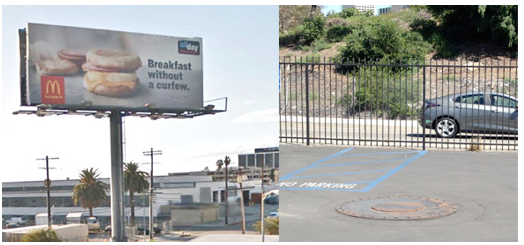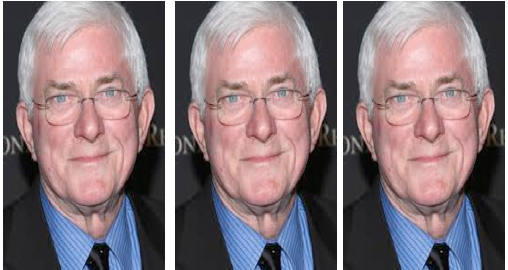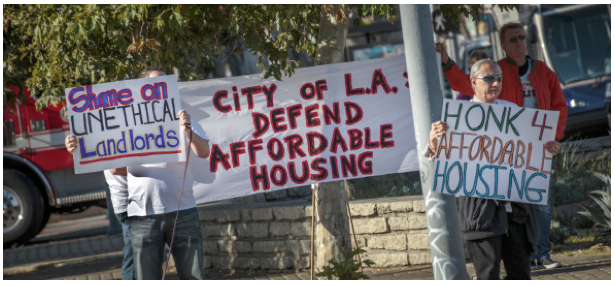DEEGAN ON LA-The threats against an elected official were of enough concern to warrant extra security precautions. The overflow crowd was, by all accounts, hostile and angry. As the meeting unfolded, four distinct parties to the dispute emerged: the Hollywood Hills West Neighborhood Council and surrounding community members, Councilmember David Ryu (CD4), the Friends of Runyon Canyon, and the Department of Recreation and Parks.
The verbal brawl and chaos at the Durant Library in Hollywood a few nights ago was prompted by a proposal for the donation of a basketball court, embedded with a corporate sponsor’s logo, planned for installation in Runyon Canyon Park.
Who knew you could purchase corporate sponsorship rights for spaces in our city’s parks? Or that there was a city department that specializes in matching up private enterprise with public entities expressly for this purpose? Or, that non-profit corporations have been created to work these private-public partnerships to support underfunded city projects?
Despite these mysteries, everyone there knew for sure that obtaining community buy-in, especially a review by the local neighborhood council, (in this case the Hollywood Hills West Neighborhood Council) would have been more than politic…it was mandatory.
Those who overlooked that piece of the review process – meaning, all three on the other side of the issue -- ruefully admitted their omission.
“What was missed was consulting with the Hollywood Hills West Neighborhood Council. The City didn't communicate as well as it could have. That’s where the frustration came from, and rightfully so,” said a spokesperson for Councilmember David Ryu (CD4.)
The Councilmember apologized to the group at the meeting, but also expressed concern about the tone and “hostile language” directed toward him and his staff, the Department of Recreation and Parks staff, the Friends of Runyon Canyon Park, and the neighborhood council.
Don Andres, VP of the Friends of Runyon Canyon Park, weighed in, saying, “Unfortunately, we did not solicit input from the Hollywood Hills West Neighborhood Council, and we should have done that, and we apologize for that. We made a false assumption that this had been communicated.”
“Going forward, the Hollywood Hills West Neighborhood Council will have a person on their board designated as park liaison. It’s a great lesson learned,” said Vicki Israel, Assistant General Manager of the Partnership and Revenue Branch at the Department of Recreation and Parks.
The cause of the heated dispute is a plan signed off on downtown that arrived as a surprise up in the hills. It would allow a clothing manufacturer to provide funds to build a basketball court in the middle of Runyon Canyon Park and “brand” it with its corporate logo.
The corporate donor has also offered to provide Rec and Parks with maintenance funding on an annual basis for a period of ten years. In purely abstract philanthropic terms, this $260,000 donation would be called a restricted gift plus an endowment: a very solid “get.” The donor would also expect a tax write-off.
The philanthropic exchange is very unbalanced right now because, while the donor may be satisfied, the community-as-recipient is not.
Councilmember David Ryu says he will speak to the City Attorney, who would need to be the one to unwind what sounds like a “done deal.” Others murmur about litigation. It’s a mess.
All groups involved -- the Hollywood Hills West Neighborhood Council, David Ryu, the Department of Recreation and Parks, and the Friends of Runyon Canyon – must figure out a way to provide the community with something they can honor instead of vilify.
Not only did the community object to the basketball court but they were also concerned with the “commercialization” of the park. Anastasia Mann, President of the Hollywood Hills West Neighborhood Council, said, “People see Runyon Canyon as a precious wilderness park... As their community park, despite the influx of out-of-the-area visitors. The community members present reflected 99% opposition to building a basketball court in the middle of the park. There are stakeholders now discussing a lawsuit and/or injunctions to halt the building of the basketball court.”
The councilmember’s spokesperson stated, “David Ryu will consult with the City Attorney’s Office in regards to the future of the basketball court project and possibly scaling the logo back.”
How does Runyon Canyon Park fit into this puzzle? Who are the Friends of Runyon Canyon”? And what is this unit at Rec and Parks that cultivates corporate sponsorships and partnerships?
A few facts and stats can help illustrate the scope and popularity of Runyon Canyon Park. This public gem, a site for which Councilmember David Ryu and the Department of Recreation and Parks are “public stewards,” is a 136-acre urban park, including a 90-acre off-leash dog park, an open space turf area and numerous hiking trails -- all situated in the wilderness of the Hollywood Hills. The park is managed by the Los Angeles Department of Recreation and Parks; it has two main entrances, off Fuller Avenue in Hollywood at the bottom of the park and off Mulholland Drive at the top of the park.
The Friends of Runyon Canyon, a private 501c-3 non-profit support group, surveyed the park visitors in April/May 2015 and found that Runyon has a diverse set of users with diverse needs. It’s a very popular regional park with about 35,000 visits per week (can be multiple visits per day by one person), 1.8 million visits per year, and 300,000 dog visits per year. Visitors from the surrounding zip code (90046) make up 20% of the visitors, while 25% are infrequent visitors or tourists. Overall, 85% of visitors come from greater LA. About one-third of its visitors are under 39 years of age, and about one-fifth are over 50 years old.
For all that went wrong -- a massive communications breakdown that shut out community input – there is an upside. With community participation and buy-in, there’s a chance to create a model program and vision for Runyon Canyon Park that can give the park sustainability, benefiting the local neighborhood and its extended community of park users – all in an era of lowered financial expectations that has meant doing more with less, unless, of course, you have some friends.
But “friends” are just what the city and the community need right now. However, like any new relationship, everyone must vibrate on the same frequency. That means the Hollywood Hills West Neighborhood Council, Councilmember David Ryu, the Friends of Runyon Canyon, and the Department of Recreation and Parks must all get in sync and come to an agreement.
Summing up the current state of the relationship and the challenges facing it, Hollywood Hills West Neighborhood Council President Anastasia Mann said, “The Friends of Runyon Canyon are nice, good, dedicated people, who have worked hard and mean well, who love Runyon Canyon and with whom HHWNC has worked and supported emotionally and financially since their inception as a 501c charitable organization. But, because of recent circumstances, if FORC wants to be trusted and therefore continue to raise money to support the park, they should be willing to take to heart the opinions of the local stakeholders, their passions, and their fears, as hard as it may be, without judging them antagonistically.”
Mann continued, “Sadly, the situation has resulted in some damage within the local stakeholder base to FORC's credibility due to their acknowledged lack of transparency about the corporate sponsorship of a basketball court in Runyon, the story behind the acquisition of the sponsorship, as well as the legal precedent it sets for the future. Legitimate questions were raised about the possible future use of the ball court site for publicity, charity events, impact on wildlife, etc. What angered people the most was the apparent avoidance of proper public disclosure, therefore input, as well as the lack of any environmental impact study (CEQA).”
“Our very engaged community here is upset that there was no proper publicly noticed process until Monday night's meeting by HHWNC at which time they were told it is "too late" to turn back. That anger seemed to blur anyone's willingness to participate in a discussion of the pros and cons of any aspect of the professionally presented proposed "Vision Plan”, added Mann.
Now, because they were overlooked in the initial process, the neighborhood council and the community actually have an advantage in round two. As tempers cool down and all sides prepare for an upcoming town forum on the topic, neighbors can be at the center of attention and can possibly leverage their influence for a better result than offered in the original plan. “Going forward, there will be town halls with CD4, the community, the Neighborhood Council and us, hopefully for a date very soon in May,” Friends of Runyon Canyon VP Don Andres told CityWatch.
The Friends of Runyon Canyon have been working on a Vision Plan for the park that extends beyond the current basketball court and logo dispute.
“The park has many challenges and needs so much infrastructure improvement,” stated Don Andres, VP of the Friends of Runyon Canyon. He continued, “If it remains unsafe, it may ultimately face closure. To ensure this wilderness area remains, we must focus on infrastructure, and so we have commissioned a landscape architect to do a Vision Plan, to get an independent view of a very large regional park in the middle of neighborhoods. What is it that we should do with this park, independent of any individual bias, or parks and recreation, and be objective?
“This Vision Plan is a conceptual set of ideas of what the park could be, not a blueprint for implementation. It focuses on a park improvement and preservation plan. How to deal with erosion control, run-down trails, DWP lines, storm water runoff, and increased public safety. LAFD frequently rescues hikers, so we must consider the public safety aspects of the overall park plan.”
Amplifying the needs, Andres continued, “We need more water fountains, better trails, repair of the east trail steps. We have a diverse set of users who don't understand some of the potential dangers of the park. We also have to know how to make park land safe, to restore it to a level that it wouldn’t erode away, and understand the importance of maintaining the sustainability of the land.
“Given the diversity and enormous number of people visiting Runyon and the related neighborhoods, the only real solution is a compromise and balanced approach”, concluded Andres.
Speaking about the Vision Plan, the Ryu spokesperson pointed out that, "80% of visitors are from outside the Hollywood area. We must consider the overall infrastructure needs of the park to make it safe for all users. On Monday, we heard from many residents who live near the park, but it's also important that we hear from as many park users as possible."
The city has opened a new branch at the Recreation and Parks Department to identify sponsorship possibilities and to cultivate prospective sponsors. The beneficiary project receives cash, and if processed through a 501(c-3) such as Friends of Runyon Canyon, the donor (such as this clothing manufacturer) receives a significant tax write-off; donors get both branding and promotion as well as a tax-deduction. That's a lot. Ideally, it would be a very discrete acknowledgement, handled appropriately, maybe on a side fence, and without commercial slogans or other marketing overtones. This requires very careful monitoring.
Vicki Israel, Assistant General Manager Partnership and Revenue Branch at the Department of Recreation and Parks, explains how this unique program works: “With budget reductions we cannot do it alone anymore, and have started creating public-private partnerships with the Department of Parks and Recreation. They are necessary and we seek them. Our naming policy and a sponsor recognition policy, that create the guidelines and policy to continue to reach out and obtain partners, were approved by the Board of Park Commissioners and the City Attorney.
“One of our partners is the Friends of Runyon Canyon that came to the Department of Parks and Recreation about their plans. We created a MOU (memorandum of understanding) that we took to the Board of Park Commissioners as public process. When it was approved, the Friends of Runyon Canyon went out to do fundraising on behalf of Runyon Canyon. They don’t want commercialization.”
When asked if it was accurate to say the basketball court donation was "facilitated by the Friends of Runyon Canyon,” FRC’s Don Andres told CityWatch, “Not really. That implies much more Friends involvement than what really happened.”
Unknown, or yet-to-be-revealed, is how this project got launched to start with -- by whom and exactly when? How did the San Francisco area-based donor know to go to an unheralded department in the city bureaucracy, if it was not with the navigation that FRC and their MOU with the department could facilitate? Now that the idea has become almost toxic, nobody seems to want to own the origin of the plan. The donor is a voice still to be heard from, although it may wind up wishing it never got involved, no matter what its good intentions. The public relations backlash could hurt more than the corporate branding in the park could help. But if the donor pulls out, that issue might dissolve.
This is a matter that needs more (hopefully civil) conversation and clarity to reach a resolution. The neighborhood council has undeniable parity as an interested party, and the councilmember has stepped in. There must be an agreement between them.
For now, considering where this dispute is taking place, let's let a Hollywood icon have the last word: “What we've got here is failure to communicate.” - Paul Newman, from the 1967 movie, “Cool Hand Luke.”
(Tim Deegan is a long-time resident and community leader in the Miracle Mile, who has served as board chair at the Mid City West Community Council and on the board of the Miracle Mile Civic Coalition. Tim can be reached at [email protected].) Edited for CityWatch by Linda Abrams.




















 The bulk of the judgment in this case is loan forgiveness for former students. The rest is to punish the shyster Corinthian and try to deter other profiteers from creating business models that prey on hopeful students. That's a good sign.
The bulk of the judgment in this case is loan forgiveness for former students. The rest is to punish the shyster Corinthian and try to deter other profiteers from creating business models that prey on hopeful students. That's a good sign. 
















